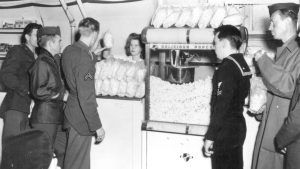#FlashbackFriday: Chill Out With Some History About the Exchange in Iceland

On July 7, 1941—81 years ago this week—4,000 Marines of the 1st Marine Brigade (Provisional) landed at Reykjavik, Iceland, to reinforce British troops who had arrived on the island, a strategic location during the early days of World War II.

Soldiers at Iceland’s first popcorn machine, introduced at the base exchange near Reykjavik during World War II.
Less than three months later, a PX opened at Camp Tadcaster (later Camp Pershing) near Reykjavik. The First Echelon (Air Corps units) and 1st Marine Brigade had Exchange operations that were consolidated into the main Exchange.
By the time the main Exchange opened on Sept. 26, 1941, the Marines had been joined by 6,200 Air Corps units that arrived in August and September. They joined British and Canadian forces that had been in Iceland since May 1940.
Troops began to anticipate the arrival of ships bringing supplies to the Exchange, guessing what merchandise might be on board. The ships’ arrivals provided a morale boost for the troops. In 1944, the Exchange introduced Iceland’s first popcorn machine, providing a taste of home for American troops.
In May 1942, three 2½-ton trucks arrived and were converted into mobile Exchanges, adapted for selling drinks and hot food. When forces were reduced, one of the trucks was sold to the Icelandic government, one was used as a general-purpose vehicle and one was donated to the Red Cross, which used it to serve coffee and doughnuts.
By the end of 1942, the Reykjavik-area Exchange, which consisted of an office building and warehouses, operated 63 “sub-exchange” branches on the small island. The sub-exchanges were accountable to the base Exchange and drew supplies form it once a week. In 1947, American forces left Iceland and the Exchanges closed.
From 1951 to 1960, with support from the Exchange, the independent Iceland Central Exchange served the Iceland Air Defense Force, a U.S. military command. The Navy Exchange Service then took over, operating a store at the Naval Air Station until 2006, when all U.S. troops left Iceland.
During World War II, troops were also stationed in such other North Atlantic outposts as Newfoundland and Greenland, and the Exchange went where the troops went. The Exchange continues to operate in Thule Air Base, Greenland. More than 700 miles north of the Arctic Circle, the Thule BX is the Exchange’s northernmost store.
Sources: One Hundred Years of Service: A History of the Army and Air Force Exchange Service; Exchange Post archives


I remember the Base in Keflavik very well. I was there in 1990 and the NEX was filled with beautiful merchandise and local Icelandic vendors. Loved my time at Keflavik!! Sad that it is now closed.
I’m wondering if anyone knows who that sailor is in the picture. When this came across my pc screen, I about fell out, since it looks exactly like my dad! My siblings thought the same when I sent them the screenshot. Would be great to know. 🙂
Wow, Trish.
It could be difficult to track down an answer because that photo is from our electronic archives and nobody in it was identified. It could take a couple of days, but let me see if I can hunt down the original and find out if there’s any information accompanying it.
Robert Philpot
The Exchange Post